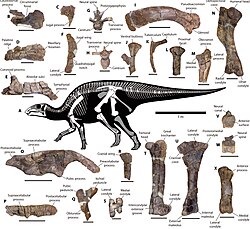Biology:Gonkoken
| Gonkoken | |
|---|---|

| |
| Scientific classification | |
| Domain: | Eukaryota |
| Kingdom: | Animalia |
| Phylum: | Chordata |
| Clade: | Dinosauria |
| Clade: | †Ornithischia |
| Clade: | †Ornithopoda |
| Superfamily: | †Hadrosauroidea |
| Genus: | †Gonkoken Alarcón-Muñoz et al., 2023 |
| Species: | †G. nanoi
|
| Binomial name | |
| †Gonkoken nanoi Alarcón-Muñoz et al., 2023
| |
Gonkoken (meaning "similar to a wild duck or swan") is an extinct genus of hadrosauroid ornithopod dinosaur from the Late Cretaceous Dorotea Formation of Chilean Patagonia. The genus contains a single species, G. nanoi, known from disarticulated bones of multiple individuals.[1]
Discovery and naming
The Gonkoken fossil specimens were discovered beginning in 2013 in sediments of the Dorotea Formation in the Río de las Chinas Valley, Estancia Cerro Guido, in Magallanes Region, Chile. The holotype specimen, CPAP 3054, consists of a right ilium. Additional material assigned as paratype includes the disarticulated bones of at least three individuals. These bones include skull material, cervical, dorsal, and caudal vertebrae, ribs, partial pectoral and pelvic girdles, and arm and leg bones.[1]
In 2023, Alarcón-Muñoz et al. described Gonkoken nanoi as a new genus and species of hadrosauroid ornithopod based on these fossil remains. The generic name, "Gonkoken", combines the Aónik’enk words "gon", meaning "same as" or "similar to" and "koken", meaning "wild duck" or "swan". The specific name, "nanoi", honors Mario "Nano" Ulloa.[1]
Description

Gonkoken was a relatively small hadrosauroid, with an approximate body length of 4 metres (13 ft). It exhibits a blend of derived hadrosaurid traits and ancestral hadrosauroid traits.[1]
Classification
Alarcón-Muñoz et al. (2023) recovered Gonkoken as a derived, non-hadrosaurid hadrosauroid, proving that these taxa survived until the very end of the Cretaceous in southern South America. It was thus unrelated to other the South American hadrosaurids, Bonapartesaurus, Huallasaurus, Kelumapusaura, and Secernosaurus, which were found to belong to their own group of saurolophine hadrosaurids called Austrokritosauria. Both groups likely dispersed to South America from North America. The results of their phylogenetic analyses are shown in the cladogram below, with South American taxa highlighted:[1]
| ||||||||||||||||||||||||||||||||||||||||||||||||||||||||||||||||||||||||||||||||||||||||||||||||||||||||||||||||||||||||||||||||||||||||||||||||||||||||||||||||||||||||||||||||||
Paleoenvironment
Gonkoken was discovered in layers of the Dorotea Formation, which dates to the lower Maastrichtian, between 71.7 ± 1.2 and 70.5 ± 5.0 million years ago.[1] The parankylosaur Stegouros has also been described from the formation.[2] Fossils belonging to amphibians, mammals, fish, reptiles, and several invertebrates have also been discovered there, along with material belonging to indeterminate sauropod, theropod, and ornithischian dinosaurs.[3]
References
- ↑ 1.0 1.1 1.2 1.3 1.4 1.5 Alarcón-Muñoz, Jhonatan; Vargas, Alexander O.; Püschel, Hans P.; Soto-Acuña, Sergio; Manríquez, Leslie; Leppe, Marcelo; Kaluza, Jonatan; Milla, Verónica et al. (2023-06-16). "Relict duck-billed dinosaurs survived into the last age of the dinosaurs in subantarctic Chile" (in en). Science Advances 9 (24). doi:10.1126/sciadv.adg2456. ISSN 2375-2548.
- ↑ Soto-Acuña, Sergio; Vargas, Alexander; Kaluza, Jonatan; Leppe, Marcelo; Botelho, Joao; Palma-Liberona, José; Gutstein, Carolina; Fernández, Roy et al. (2021). "Bizarre tail weaponry in a transitional ankylosaur from subantarctic Chile". Nature 600 (7888): 259–263. doi:10.1038/s41586-021-04147-1. PMID 34853468. Bibcode: 2021Natur.600..259S. https://www.researchsquare.com/article/rs-821192/v1.
- ↑ Alarcón-Muñoz, Jhonatan; Soto-Acuña, Sergio; Manríquez, Leslie M. E.; Fernández, Roy A.; Bajor, Dániel; Guevara, Juan Pablo; Suazo Lara, Felipe; Leppe, Marcelo A. et al. (2020-10-01). "Freshwater turtles (Testudines: Pleurodira) in the Upper Cretaceous of Chilean Patagonia" (in en). Journal of South American Earth Sciences 102: 102652. doi:10.1016/j.jsames.2020.102652. ISSN 0895-9811. Bibcode: 2020JSAES.10202652A. https://www.sciencedirect.com/science/article/pii/S0895981120301954.
Wikidata ☰ Q119585708 entry
 |
